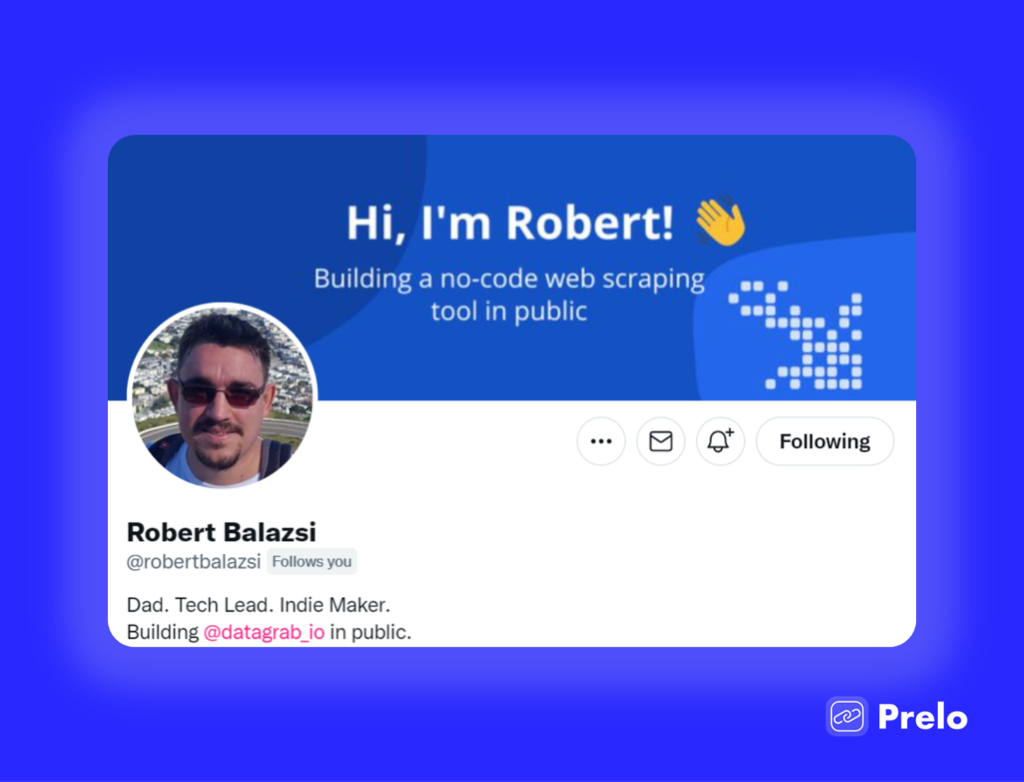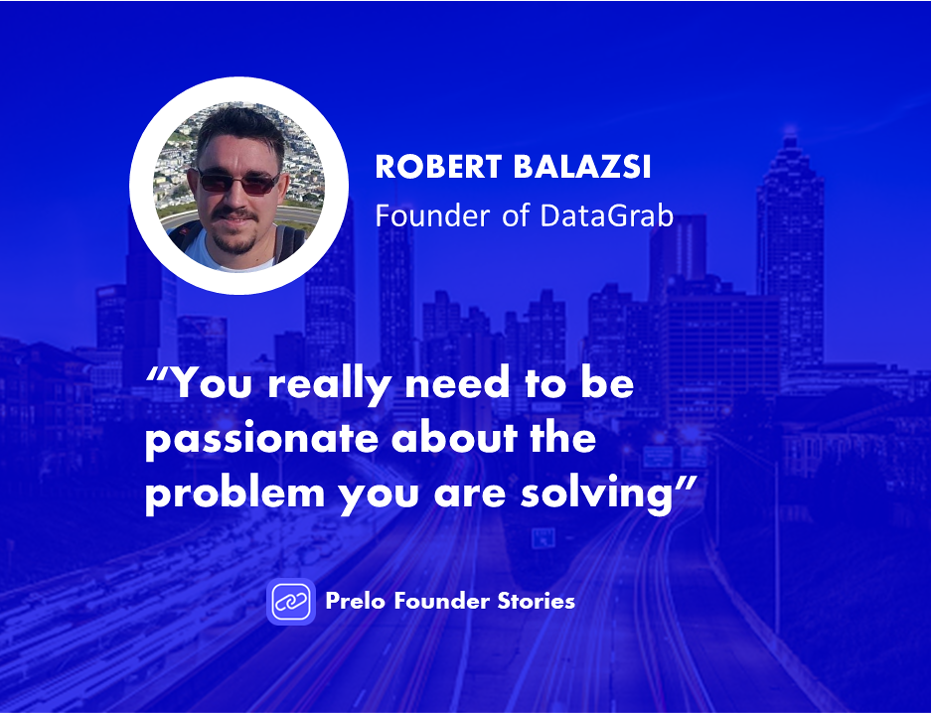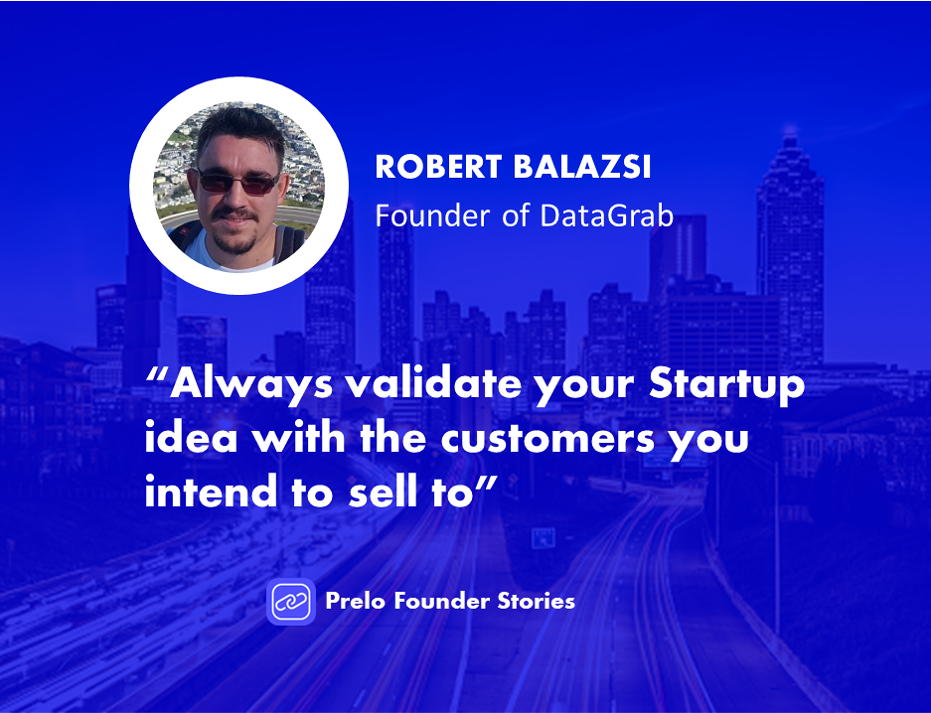On Founder Stories today, I will be catching up with non-other than the founder of DataGrab, and one of our partners Robert Balazsi sharing his startup journey with us. DataGrab is a B2B web scraping cloud platform designed to build web scrapers without writing a single line of code 😲
I’m looking forward to learning how Startups and Small Businesses (SMBs) are using DataGrab to build no-code web scrapers at scale.
The month of May started off with a bang 💥. Emily and I spent 2 weeks in London strategizing our next steps, and how we plan to help founders with marketing and mental health.
As we continue to build out our founder community, we also stepped up our marketing efforts, resulting in our highest monthly revenue to date. We more than 2x our previous highest revenue 🚀
…but before we get started, I’d love to connect with you!
Soooo, let’s do it follow me on twitter (DMs always open) 📨
Welcome to the Founder Stories Podcast Robert, and thank you for joining us today. I’m interested in finding out about you and your founder journey into entrepreneurship.
💡 Tell us about your Startup Journey

So, I actually began my startup journey as an Indie maker (independent developer) quite a few years ago. Starting with a simple project, nothing related to web scraping. Then I started by building an image creator, of course that went nowhere.
Moving on, I created several little projects that I could not monetise, because I never spoke with customers and I didn’t engage with any communities. However, what led me to building DataGrab and into web scraping was an interesting story.
Several years ago, I was looking for a phone upgrade, so I started checking out price alternatives to Samsung Galaxy S6 phones. I am based in Romania, so you can just imagine it was pretty tedious.
I did all my research manually, creating an excel spreadsheet and then trawling hundreds of websites. Don’t forget, I had to also monitor the sites for new stock. Suddenly, it occurred to me that, what if I could somehow automate all these laborious tasks. Just imagine how much time it would give me back every week.
💡 That Aha Moment!
This was my “aha moment”, it was my first entrepreneurial itch. Nevertheless, I completed my cell phone research manually and gave up on web scraping. A few months after that, I found myself on a user group website, a website where you ask technical questions and various experts come to answer them. I can’t remember what my question was now…maybe something about UI design.
Every few days, I’d go back to the website, login and expectantly check to find out if my question had been answered, nothing. What if I could automate the arduous task – bingo! another excellent use case for creating a web scraping solution .
That was the second and final, use case that got me into web scraping. The funny thing was that I didn’t know what web scraping meant then. It didn’t occur to me that there was a whole data scraping industry out there.
💡 How to build a product and monetize a Startup
My next challenge was, trying to work out how to build a product and monetize it. This led me down another path, where I had to learn UI/UX design.
I explored a lot of industries as you can imagine. Being an indie maker, you’re required to know everything from content marketing to product development. I read a lot of books and then set out to build a business around it. This was how DataGrab was born and that was almost five years ago!
I built DataGrab myself in complete isolation (not advisable), but the most amazing thing happened to me during that journey. I found out about build in public and I became active on Twitter. This was where I met you and other incredible people. For me, this was the best decision I ever made.
Today DataGrab is a platform, a cloud solution that allows our customers to scrape multiple pages in parallel using it’s built-in concurrency solution.
💡 Should your Startup be solving a problem you had?

For me, the best way to build a Startup is by trying to solve a problem that you have. It’s the easiest way to come up with a Startup idea that actually has the potential to succeed.
Focus on solving a problem you have and “dog food” your own product.
dog food – use your own product to solve your problem with the focus on improving it.
There is a caveat to all this though, and that is to make sure that the problem is a big enough problem to build a business around. The most important thing you can do is to talk to people as you build out your product. If you can, I urge you to start before you build the product. Ask them about their pain-points.
There are many methodologies to help you with this. Michele Hansen has a great book titled “deploy empathy” the book teaches Startup founders about getting information from potential customers and connecting with them.
So to answer your question – yes, it’s really good if you your Startup journey begins with a problem you have.
I’ll tell you a little story in the next section, this story enforces my belief as to why you need to focus on building a Startup around a problem you have.
💡 Why passion matters when building a Startup – a story

Here’s that story, remember that I said it took me five years to build DataGrab. Well there was a 6 month period where I got side-tracked into email marketing.
I wanted to create a tool similar to Mailchimp. A simple drag and drop editor to put together emails and send them out to prospects.
I’m bringing this up because I gave up after just 6 months! Why, because I didn’t personally have the problem I was trying to solve, and I didn’t have customers to help me test the product. I had no one interested in launching email campaigns, and I wasn’t a marketer.
I mean we knew it was a problem to be solved and there was a huge market for email marketing tools, but I didn’t have the problem and I wasn’t that passionate about it.
As I found out, designing good email copy is a whole new domain which I wasn’t familiar with and quite frankly had no interest in. So you guessed it, I gave up.
For me this validates my thought process, you really need to be passionate about the problem you are solving.
💡 How did you validate your Startup idea ?
As I began my research for DataGrab, I quickly realised that there were tons of use cases, especially those involving non-technical people.
With lead generation being a big use case, I worked out that marketers, Sales Development Reps (SDR), and Business Development Reps (BDRs) are typically the target audience for lead generation tools, these are all use cases for non-technical people.
Finding non-technical folks was a starting point, but I did more research only to find out that actually, developers also wanted lead generation services. The odd thing was that they could write their own code. So the question I had was this “Were they really a use case for DataGrab?” You guessed it “They Were!”
You’ll be surprised how lazy we are as developers. Developers have a need for web scraping and for the record, I have customers of DataGrab who are programmers.
💡 Going All-in On the research
As I continued into my competitor research through my Startup journey, I found a few tools including data.io. Since they were already in the market and they had tons of blog posts and lots of backlinks, I was convinced that there was a market.
I also did some research on Reddit and I got involved in Indie hackers so I submitted my product. That was a really good decision. Reddit is a great place to engage with people, I pitched my product if I felt that it was relevant and in the context of a particular conversation.
I started to get people signing up, this was how I developed the first set of features. It’s far from perfect, but we are progressing, thanks to customer feedback.
You know, once you’ve identified that there are some potential customer personas for your product, that is your first signal. Those potential customers will give you feedback once you have something you can actually validate.
So to summarise our validation process here are 7 things we did right :
- Checked out the broad topic of data scraping.
- Narrowed it to one use case.
- Looked for the personas that had the biggest pain-point
- Delved into other personas.
- Reached out into communities where those personas were and asked about their issues regarding this particular use case.
- Prioritised those issues and built an MVP which I shared for feedback.
- Received tons of feedback and that was essentially how we validated DataGrab.
💡 Will you position your Startup as a B2B enterprise solution ?
Yes, exactly and you do bring up a great point actually. So interestingly, all of my paying customers including customers building side gigs are actually B2B businesses.
So, they are actually building businesses on top of that data aggregation. That includes price comparison tools and so much more.
So, it makes sense for us to build DataGrab as a B2B enterprise solution.
In a lot of cases, while it may be harder to get a B2B sale, we feel that it is several orders of magnitude harder to scale a B2C Startup than it is to scale a B2B Startup. B2B Startups are a little slower usually because you may have to deal with multiple decisions makers, but overall this is the right place to be for DataGrab.
Unless it’s an independent developer or a small Startup, the buyer and the end user personas are not the same people. This is the simplest way I can put it and I’m pretty sure you also experience this too at Prelo.
When you start playing in the B2B domain, the users require a lot more data. It’s no longer a hobby project and they are happy to pay more.
Right now, at DataGrab we only work with B2B companies and that’s how we plan to continue for the foreseeable future.
💡 Target your ideal customers early in your startup journey ?

Always validate your Startup with the customers you plan to sell to. If you don’t do that, there is a hidden trap, what I call a false positive (or false negative), when you try to recruit fellow developers to help you validate and test.
They see things differently; if they are not your ideal customer, and they haven’t experienced the pain-point you are trying to solve for you could end up building a product that doesn’t address your intended customer’s pain-point.
There is also a trap, that you develop a set of features which is perfect for indie makers, but unsuitable for scaling up for a B2B client.
Or worse, they want something completely different.
Here is a real example.
When Indie Developers use DataGrab, they use it to scrape data once in a while and this is great for what they want. Once we introduced B2B companies, they wanted to have the capability to Schedule Scrapers.
So, a message to founders is this :
“don’t be afraid to start targeting your ideal customers from day one”.
💡 What advice you would give first-time founders ?
The best advice I can give a first time founder on their Startup journey, is to build in public. In most cases that’s the best way to build a Startup. I mean unless you are building a product for a nuclear plant facility, then perhaps don’t do that in public (laughs).
Building in public is a great way to get feedback and a fantastic opportunity to promote your product to potential customers.
I share Arvid Kahl’s view on this, he wrote this outstanding book, the embedded entrepreneur which I recommend that people read. It lays down the process and the template for building in public.
💡 What do you need help with ?
I really like the idea of connecting in a Slack community, similar to what you have at Prelo. I’m looking for somewhere to connect with Founders. I’m looking for Startup founders who need a tool like DataGrab.
💡 What’s been the biggest challenge of your Startup Journey ?
The biggest challenge has been uncertainty, I’m much happier now that I’m finally in a better position to do things that actually move the needle.
Developing DataGrab and finding those marketing channels that actually result in tangible revenue uplifts has been the biggest challenge for me throughout my Startup journey.
Twitter: https://twitter.com/robertbalazsi
Website: https://datagrab.io
Tired of pitching to Startups with zero budget?
👉 Try Prelo
Prelo connects Solopreneurs to recently funded Startups in 3-Clicks
💡 Access over 1 million highly curated decision makers from well funded Startups
😲 Discover Emails and Business Contacts in seconds
🎯 Send super targeted emails to well-funded Startups and 10x your revenue
On twitter : 🐤 @oluadedj
subscribe : 📰 prelo newsletter
We’ll catch up again soon, many blogs coming up.
Olu
Founder, Prelo
I tweet about helping founders win!



